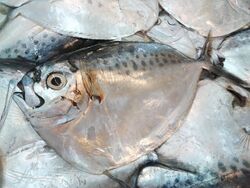Biology:Mene
| Mene | |
|---|---|

| |
| Mene maculata | |
| Scientific classification | |
| Domain: | Eukaryota |
| Kingdom: | Animalia |
| Phylum: | Chordata |
| Class: | Actinopterygii |
| Order: | Carangiformes |
| Family: | Menidae Fitzinger, 1873 |
| Genus: | Mene Lacépède, 1803 |
| Species | |
| |
| Synonyms | |
| |
The moonfish of the genus Mene, the sole extant genus of the family Menidae, are disk-shaped fish which bear a vague resemblance to gourami, thanks to their thread-like pelvic fins. Today, the genus is represented only by Mene maculata of the Indo-Pacific, where it is a popular food fish, especially in the Philippines , where it is known as bilong-bilong, chabita, hiwas or tahas.[2]
As a genus, Mene has a long fossil history, with species found in marine sediments throughout the Cenozoic Era.[3] The earliest accepted species, M. purdyi from the Paleocene of Peru, resemble later species, such as M. rhombea of the Monte Bolca lagerstätte, and even the living species, M. maculata. Experts remain undecided whether the Tunisian species, M. phosphatica is from the Lower Paleocene, thus making it older than M. purdyi, or whether it is from the Ypresian epoch of the Eocene. Almost all of the species are known primarily from the Paleogene; the Neogene record is rather sparse, if not totally nonexistent, with some otoliths found in Miocene strata, and no whole or even partial specimens known from Pliocene or Pleistocene strata.
Anatomical and recent molecular studies strongly suggest a relationship with the pomfrets, dolphinfishes, remoras and the jacks in the order Carangiformes.[4]
- †Mene phosphatica, lover Paleocene, Tunisia
- †Mene purdyi, upper Paleocene, Peru
- †Mene triangulum, upper Paleocene?, Turkmenistan
- †Mene sp., lover Eocene, Denmark
- †Menidarum ornatissimus, early Eocene, France
- †Leiomene kapurdiensis, lover Eocene, India
- †Mene rhombea, middle Eocene, Italy
- †Mene oblonga, middle Eocene, Italy
- †Menidarum occultus, middle Eocene, India
- †Mene sekharani,Eocene, France
- †Mene oblonga, Oligocene, France
- †Mene novaehispaniae, Oligocene, Antigua
Mene sp, from Fur Formation, Denmark
Mene rhombea, from Bolca
Mene oblonga and Mene rhombea restorations
Timeline
<timeline> ImageSize = width:1000px height:auto barincrement:15px PlotArea = left:10px bottom:50px top:10px right:10px
Period = from:-65.5 till:10 TimeAxis = orientation:horizontal ScaleMajor = unit:year increment:5 start:-65.5 ScaleMinor = unit:year increment:1 start:-65.5 TimeAxis = orientation:hor AlignBars = justify
Colors =
#legends id:CAR value:claret id:ANK value:rgb(0.4,0.3,0.196) id:HER value:teal id:HAD value:green id:OMN value:blue id:black value:black id:white value:white id:cenozoic value:rgb(0.54,0.54,0.258) id:paleogene value:rgb(0.99,0.6,0.32) id:paleocene value:rgb(0.99,0.65,0.37) id:eocene value:rgb(0.99,0.71,0.42) id:oligocene value:rgb(0.99,0.75,0.48) id:neogene value:rgb(0.999999,0.9,0.1) id:miocene value:rgb(0.999999,0.999999,0) id:pliocene value:rgb(0.97,0.98,0.68) id:quaternary value:rgb(0.98,0.98,0.5) id:pleistocene value:rgb(0.999999,0.95,0.68) id:holocene value:rgb(0.999,0.95,0.88)
BarData=
bar:eratop bar:space bar:periodtop bar:space bar:NAM1
bar:space bar:period bar:space bar:era
PlotData=
align:center textcolor:black fontsize:M mark:(line,black) width:25 shift:(7,-4) bar:periodtop from: -65.5 till: -55.8 color:paleocene text:Paleocene from: -55.8 till: -33.9 color:eocene text:Eocene from: -33.9 till: -23.03 color:oligocene text:Oligocene from: -23.03 till: -5.332 color:miocene text:Miocene from: -5.332 till: -2.588 color:pliocene text:Plio. from: -2.588 till: -0.0117 color:pleistocene text:Pleist. from: -0.0117 till: 0 color:holocene text:H.
bar:eratop from: -65.5 till: -23.03 color:paleogene text:Paleogene from: -23.03 till: -2.588 color:neogene text:Neogene from: -2.588 till: 0 color:quaternary text:Q.
PlotData=
align:left fontsize:M mark:(line,white) width:5 anchor:till align:left
color:eocene bar:NAM1 from: -55.8 till: 0 text: Mene
PlotData=
align:center textcolor:black fontsize:M mark:(line,black) width:25
bar:period from: -65.5 till: -55.8 color:paleocene text:Paleocene from: -55.8 till: -33.9 color:eocene text:Eocene from: -33.9 till: -23.03 color:oligocene text:Oligocene from: -23.03 till: -5.332 color:miocene text:Miocene from: -5.332 till: -2.588 color:pliocene text:Plio. from: -2.588 till: -0.0117 color:pleistocene text:Pleist. from: -0.0117 till: 0 color:holocene text:H.
bar:era from: -65.5 till: -23.03 color:paleogene text:Paleogene from: -23.03 till: -2.588 color:neogene text:Neogene from: -2.588 till: 0 color:quaternary text:Q.
</timeline>
References
- ↑ Sepkoski, Jack (2002). "A compendium of fossil marine animal genera". Bulletins of American Paleontology 364: 560. Archived from the original on 2011-07-23. https://web.archive.org/web/20110723131237/http://strata.ummp.lsa.umich.edu/jack/showgenera.php?taxon=611&rank=class. Retrieved 2007-12-25.
- ↑ Small-scale fisheries of San Miguel Bay, Philippines: options for management and research. ISBN:971-10-2208-7.
- ↑ Matt Friedman, and G. David Johnson. “A New Species of Mene (Perciformes: Menidae) from the Paleocene of South America, with Notes on Paleoenvironment and a Brief Review of Menid Fishes.” Journal of Vertebrate Paleontology, vol. 25, no. 4, 2005, pp. 770–83. JSTOR, http://www.jstor.org/stable/4524505.
- ↑ J. S. Nelson; T. C. Grande; M. V. H. Wilson (2016). Fishes of the World (5th ed.). Wiley. pp. 380. ISBN 978-1-118-34233-6. https://sites.google.com/site/fotw5th/.
External links
Wikidata ☰ Q325846 entry
 |




